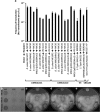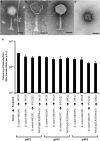Viunalikeviruses are environmentally common agents of horizontal gene transfer in pathogens and biocontrol bacteria
- PMID: 25118075
- PMCID: PMC4184006
- DOI: 10.1038/ismej.2014.150
Viunalikeviruses are environmentally common agents of horizontal gene transfer in pathogens and biocontrol bacteria
Abstract
Bacteriophages have been used as natural biocontrol and therapeutic agents, but also as biotechnological tools for bacterial engineering. We showed recently that the transducing bacteriophage ϕMAM1 is a ViI-like phage and a member of the new genus, 'Viunalikevirus'. Here, we show that four additional ViI-like phages and three new environmentally isolated viunalikeviruses, all infecting plant and human pathogens, are very efficient generalised transducers capable of transducing chromosomal markers at frequencies of up to 10(-4) transductants per plaque-forming unit. We also demonstrate the interstrain transduction of plasmids and chromosomal markers, including genes involved in anabolism, genes for virulence and genes encoding secondary metabolites involved in biocontrol. We propose that all viunalikeviruses are likely to perform efficient horizontal gene transfer. Viunalikeviruses therefore represent useful agents for functional genomics and bacterial engineering, and for chemical and synthetic biology studies, but could be viewed as inappropriate choices for phage therapy.
Figures


Similar articles
-
Bacteriophage ϕMAM1, a viunalikevirus, is a broad-host-range, high-efficiency generalized transducer that infects environmental and clinical isolates of the enterobacterial genera Serratia and Kluyvera.Appl Environ Microbiol. 2014 Oct;80(20):6446-57. doi: 10.1128/AEM.01546-14. Epub 2014 Aug 8. Appl Environ Microbiol. 2014. PMID: 25107968 Free PMC article.
-
Staphylococcus epidermidis Phages Transduce Antimicrobial Resistance Plasmids and Mobilize Chromosomal Islands.mSphere. 2021 May 12;6(3):e00223-21. doi: 10.1128/mSphere.00223-21. mSphere. 2021. PMID: 33980677 Free PMC article.
-
A generalized transducing phage (phiIF3) for the genomically sequenced Serratia marcescens strain Db11: a tool for functional genomics of an opportunistic human pathogen.Microbiology (Reading). 2006 Jun;152(Pt 6):1701-1708. doi: 10.1099/mic.0.28712-0. Microbiology (Reading). 2006. PMID: 16735733
-
Bacteriophage-mediated spread of bacterial virulence genes.Curr Opin Microbiol. 2015 Feb;23:171-8. doi: 10.1016/j.mib.2014.11.019. Epub 2014 Dec 19. Curr Opin Microbiol. 2015. PMID: 25528295 Review.
-
Bacteriophages and genetic mobilization in sewage and faecally polluted environments.Microb Biotechnol. 2011 Nov;4(6):725-34. doi: 10.1111/j.1751-7915.2011.00264.x. Epub 2011 Apr 27. Microb Biotechnol. 2011. PMID: 21535427 Free PMC article. Review.
Cited by
-
Solanimycin: Biosynthesis and Distribution of a New Antifungal Antibiotic Regulated by Two Quorum-Sensing Systems.mBio. 2022 Dec 20;13(6):e0247222. doi: 10.1128/mbio.02472-22. Epub 2022 Oct 10. mBio. 2022. PMID: 36214559 Free PMC article.
-
Hypermodified DNA in Viruses of E. coli and Salmonella.EcoSal Plus. 2021 Dec 15;9(2):eESP00282019. doi: 10.1128/ecosalplus.ESP-0028-2019. Epub 2021 Sep 28. EcoSal Plus. 2021. PMID: 34910575 Free PMC article. Review.
-
Quality and safety requirements for sustainable phage therapy products.Pharm Res. 2015 Jul;32(7):2173-9. doi: 10.1007/s11095-014-1617-7. Epub 2015 Jan 14. Pharm Res. 2015. PMID: 25585954 Free PMC article.
-
High Frequency and Diversity of Antimicrobial Activities Produced by Nasal Staphylococcus Strains against Bacterial Competitors.PLoS Pathog. 2016 Aug 4;12(8):e1005812. doi: 10.1371/journal.ppat.1005812. eCollection 2016 Aug. PLoS Pathog. 2016. PMID: 27490492 Free PMC article.
-
A Plasmid-Transposon Hybrid Mutagenesis System Effective in a Broad Range of Enterobacteria.Front Microbiol. 2015 Dec 22;6:1442. doi: 10.3389/fmicb.2015.01442. eCollection 2015. Front Microbiol. 2015. PMID: 26733980 Free PMC article.
References
-
- Ackermann HW, Brochu G, Emadi Konjin HP. Classification of Acinetobacter phages. Arch Virol. 1994;135:345–354. - PubMed
Publication types
MeSH terms
Substances
Grants and funding
LinkOut - more resources
Full Text Sources
Other Literature Sources
Molecular Biology Databases

